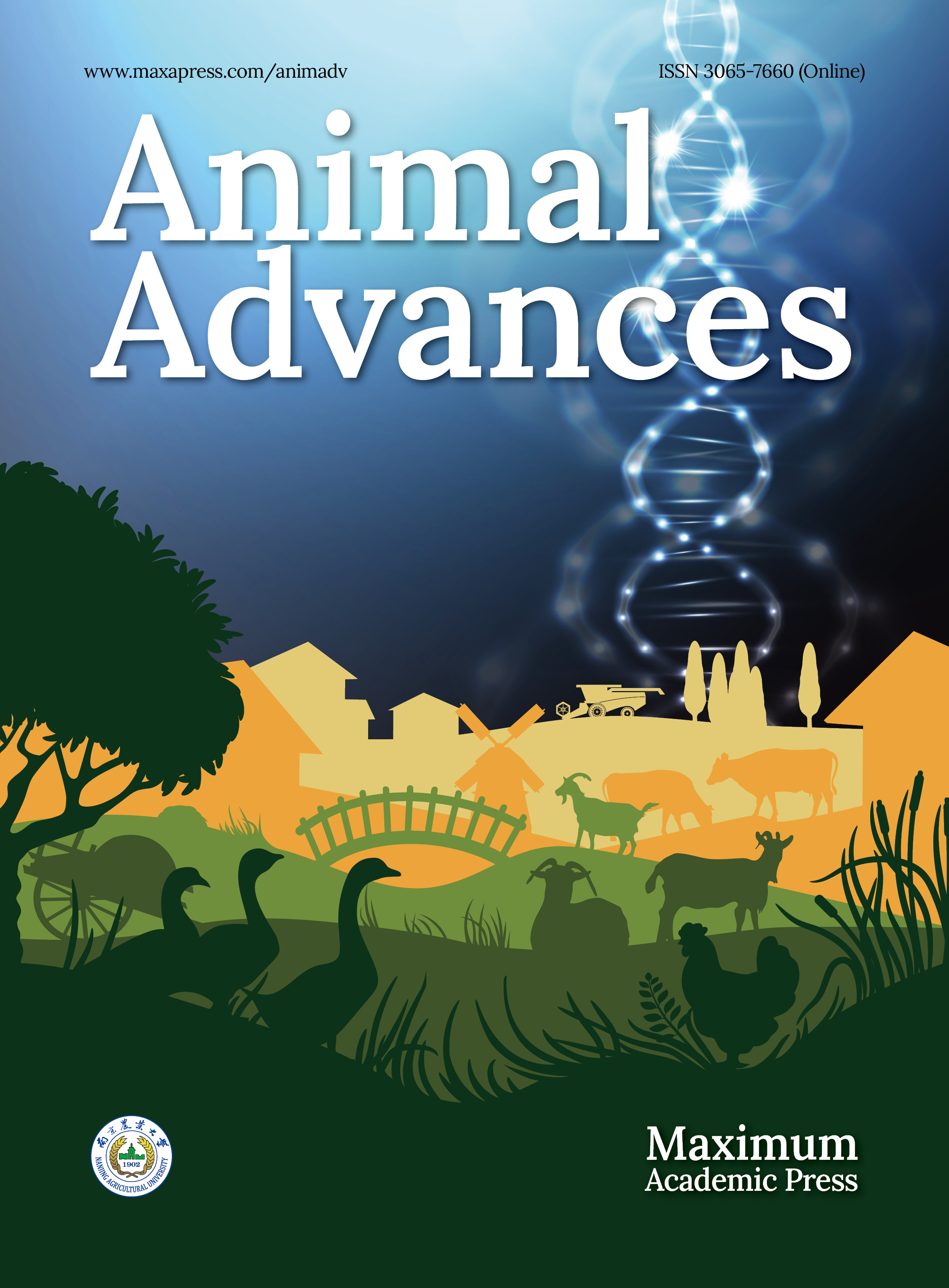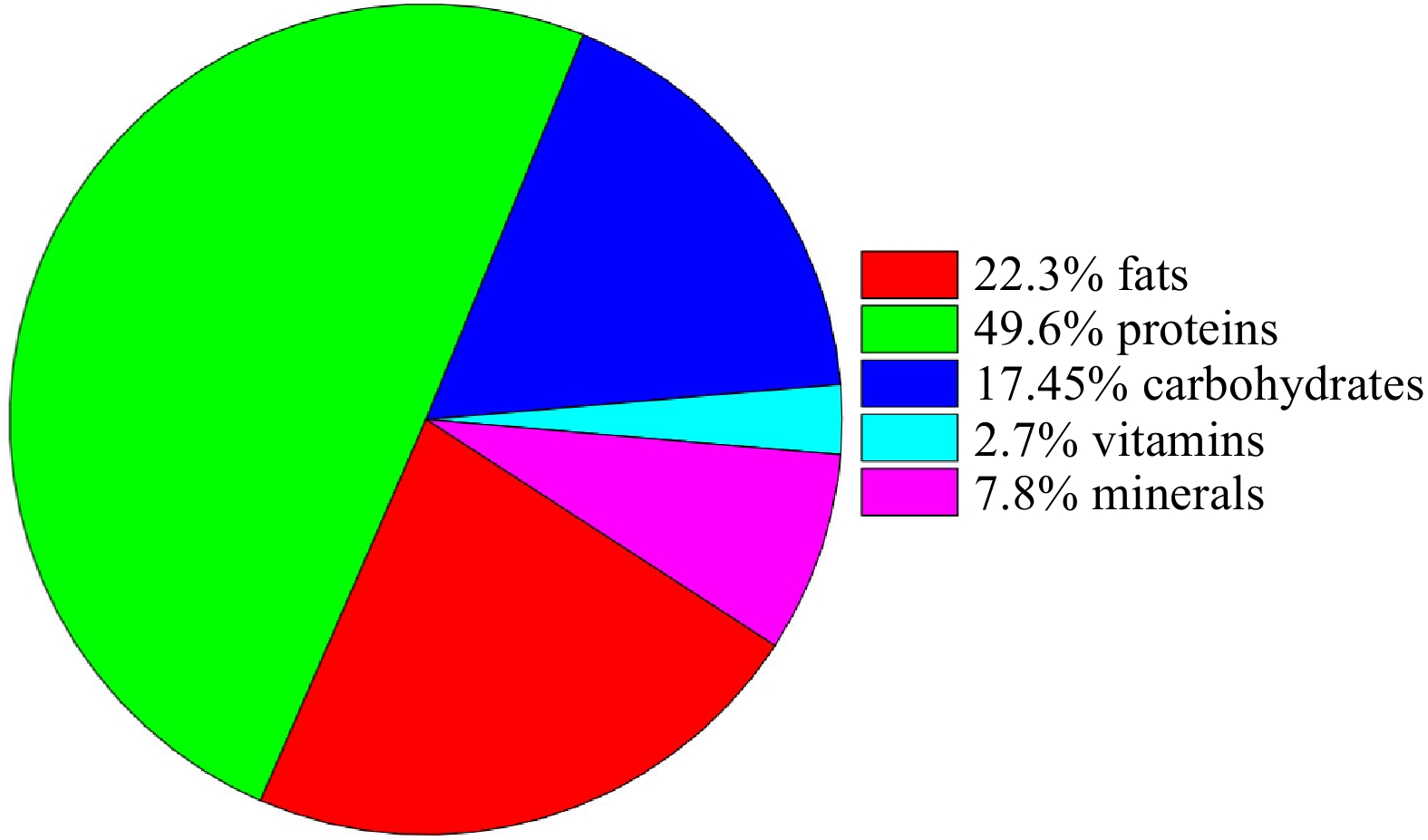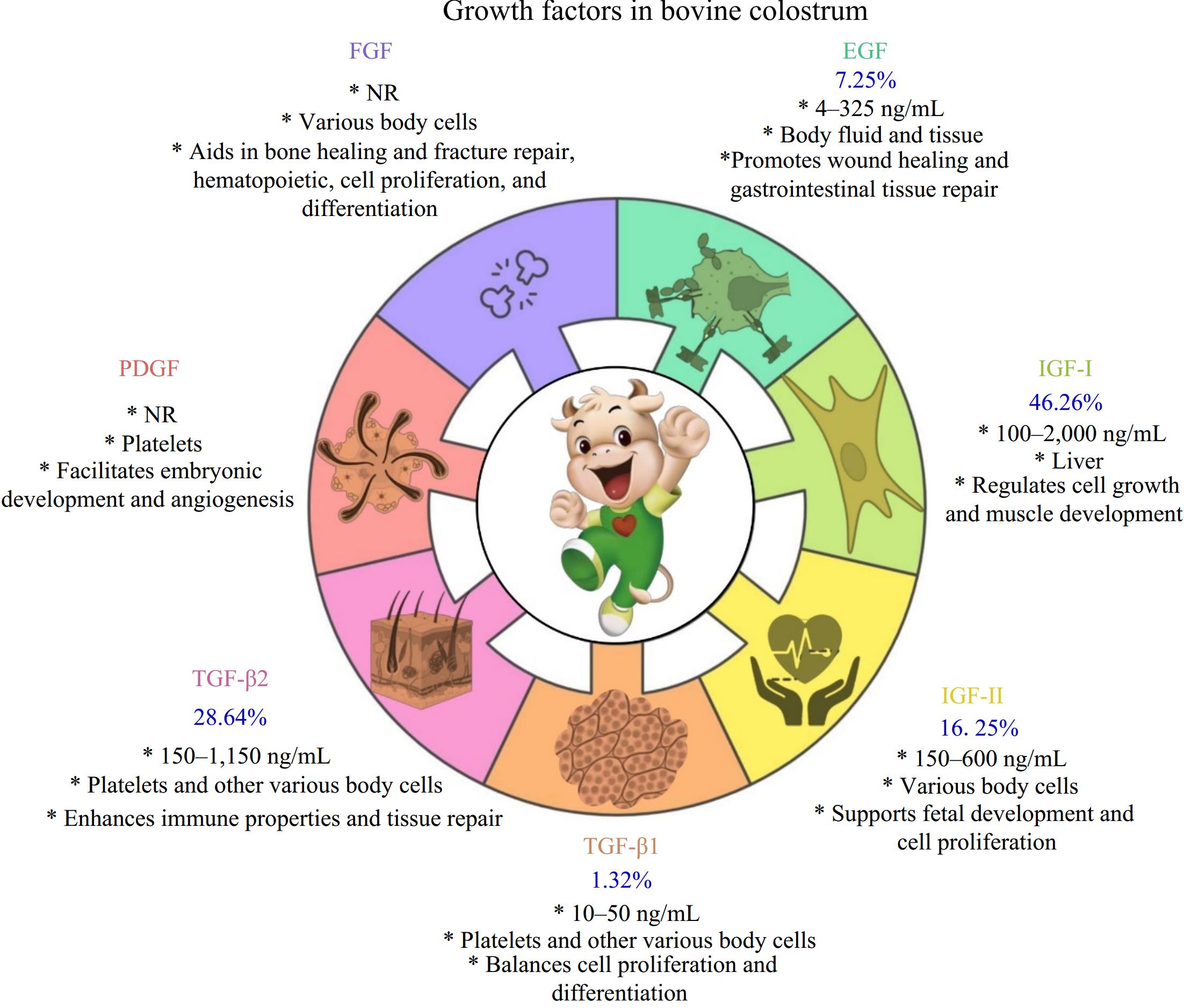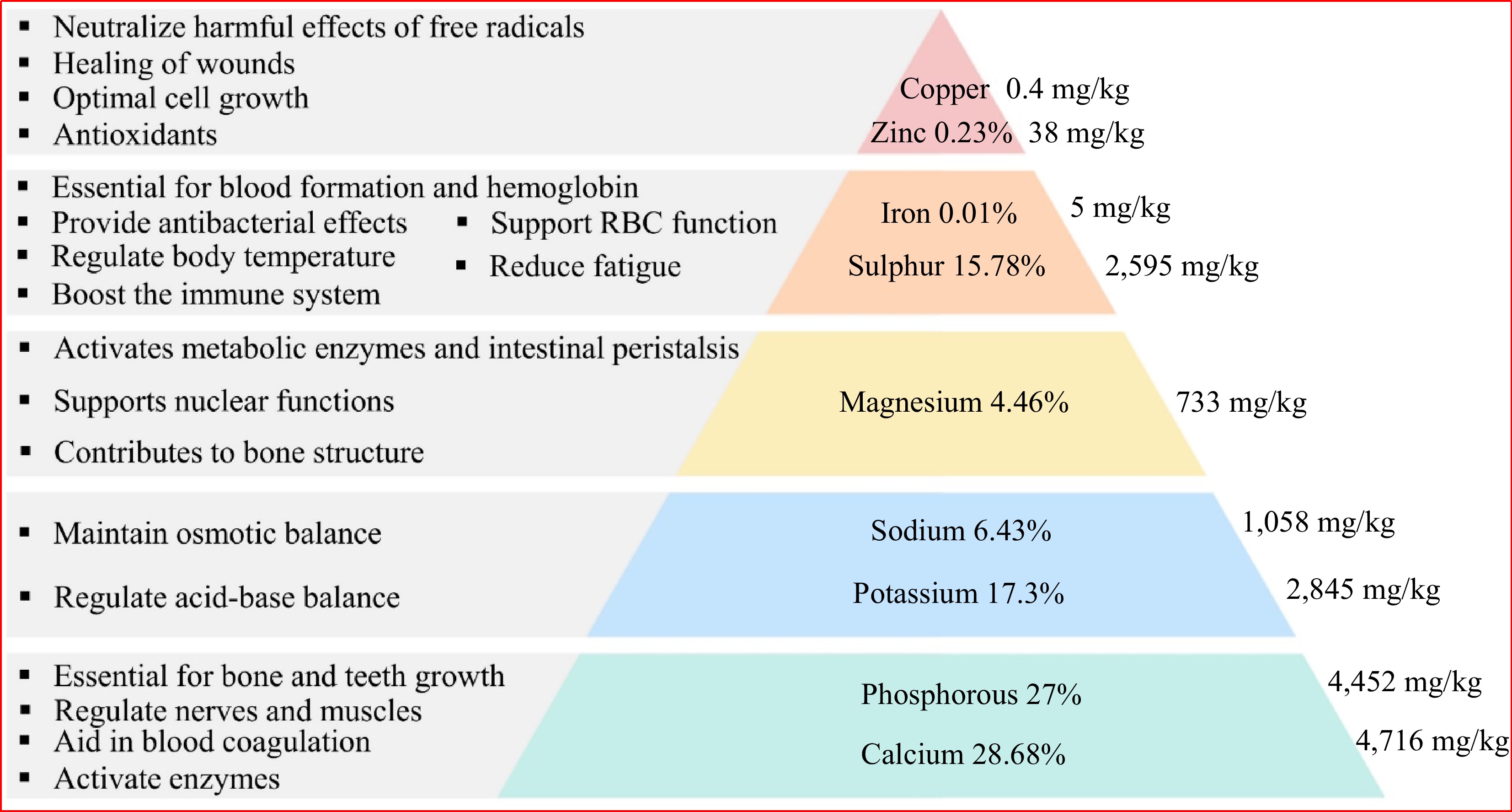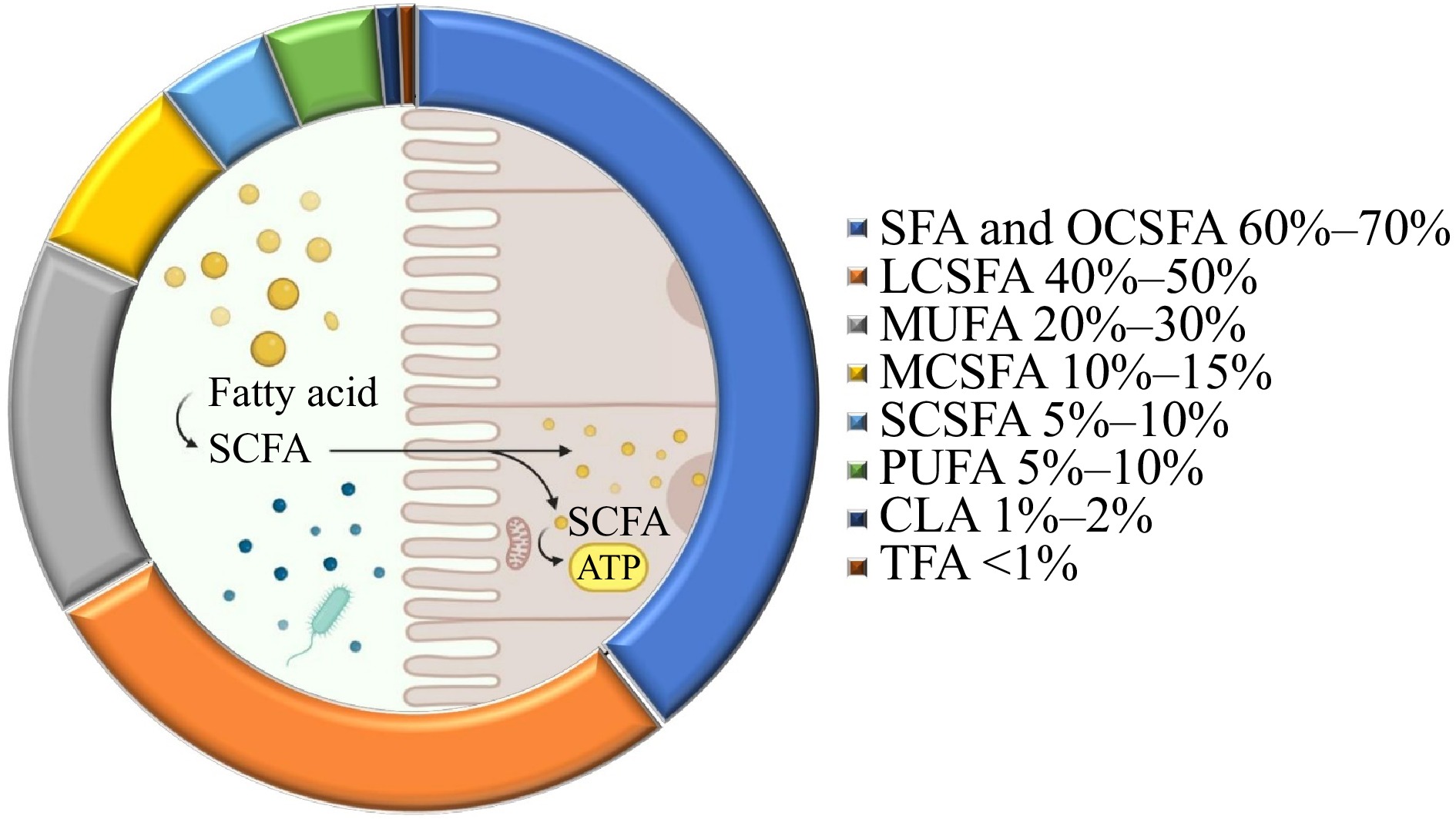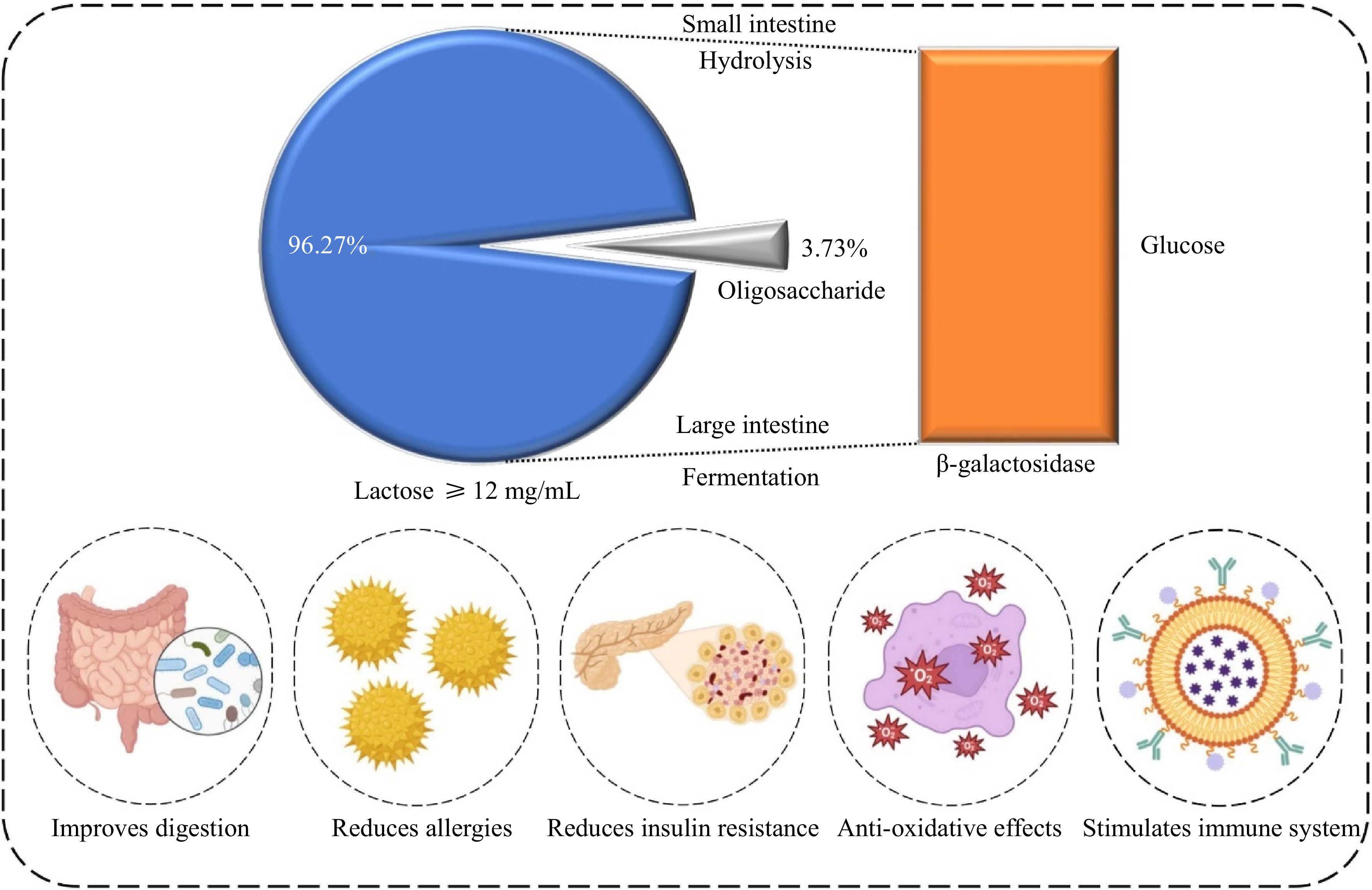-
The first year of life is crucial for immune system development in infants. To prevent harmful inflammatory reactions to food antigens, allergens, and commensal microorganisms during this time, accurate immune response management is crucial. Because colostrum had far greater antibody levels right after delivery than regular milk, it was recommended as a baby diet in 1920 to protect them from infections that humans and cows carry. Because of its antibacterial qualities, colostrum was strongly recommended by doctors before the introduction of sulfa medications and antibiotics[1]. The first polio vaccine was subsequently developed by utilizing isolated antibodies from bovine colostrum (BC)[2]. The main components of BC include both nutritional and physiologically active compounds. Nutritional components include proteins, fats, water-soluble vitamins, minerals (phosphates, chlorides, and citrates), essential and non-essential amino acids, fatty acids (conjugated linoleic acid, trans-fatty acids, and long and branched-chain fatty acids), and carbohydrates (lactose, oligosaccharides)[3]. Immunoglobulins (IgG, IgA, SIgA, IgE, IgD, and IgM), growth factors (transforming growth factor (TGF) β1 and β2, insulin-like growth factors (IGF) I and II, hormones (prolactin, estradiol, and estriol), enzymes (proteinases, antioxidant enzymes like superoxide dismutase, lysozyme, and lactoperoxidase), inhibitors (trypsin, cysteine, and protease), as well as lactoferrin, cytokines, leucocytes, nucleosides, and nucleotides are aforementioned biologically active components[4]. Except for lactose, the concentrations of these nutritious and bioactive substances are higher right after parturition and then fall after calving. The purpose of this review is to investigate the nutritional value, bioactive ingredients, as well as potential health effects of BC. It explores the effects of bovine immunoglobulins on the human immune system while highlighting their health benefits. The final section of the paper examines nutritional and bioactive components, including their mechanisms of action, compositional determinants, and beneficial effects on human health.
-
The complex nutrient-rich biological fluid known as colostrum is produced by female mammals as the first nourishment after birth. It gives a young animal a high-quality, nutritious diet and helps them establish his immunity by promoting development, tissue repair, and immunity[5] (Table 1 & Fig. 1). The physico-chemical characteristics and composition of colostrum differs considerably from those of regular milk, which means that their biological role as fractional sources or for health promotion is reversed[6]. Given the significant variations in nutritional value among varieties, milk can assist in selecting the most nutrient-dense options for human consumption[1,7]. Nevertheless, the first few days see a significant change in the physicochemical makeup, setting it apart from mature milk. It is regarded as one of the greatest natural food additives since it is a great source of macronutrients (proteins, carbs, and fat) and micronutrients (vitamins, minerals, and antioxidants). It additionally contains high levels of several bioactive compounds[8,9]. Generally, colostrum does not contain as much lactose but rather more proteins, fats, immunoglobulins, minerals, vitamins, hormones, growth factors, cytokines, and nucleotides than normal milk, all these components' contents (except lactose) decline quickly during the initial three days postpartum.
Component Units Colostrum Mature milk Dry matter mg/ml 153–245 125 IgG1 mg/ml 50–90 0.3–0.4 Ash content mg/ml 5–20 7 Protein mg/ml 41–140 37–40 Fat mg/ml 39–67 37–42 Lactose mg/ml ≥ 12 26–44 IgA mg/ml 3–6.5 0.04–0.06 IgM mg/ml 3.8–6.0 0.03–0.06 IgG2 mg/ml 1.5–2.0 0.03–0.08 Lactoferrin mg/ml 1.5–5.0 0.1–0.3 Lactoperoxidase mg/L 11–45 13–30 Lysozyme mg/L 0.14–0.7 0.07–0.6 β-carotene μg/L 100–3,400 200 IGF-I μg/L 100–2,000 < 25 TGF-β2 μg/L 150–1,150 < 5 IGF-II μg/L 150–600 < 10 EGF μg/L 4–325 < 10 TGF-β1 μg/L 10–50 < 5 BC and mature milk exhibit significant differences in nutritional and bioactive component composition, reflecting their distinct physiological roles. Colostrum, produced in the early postpartum period, is a vital source of concentrated nutrients, immunological factors, and growth components to support neonatal development. In contrast, mature milk fulfills the nutritional needs of growing calves in a more balanced but less concentrated form.
Nutritional components
-
• Dry matter and protein content are notably higher in colostrum (153–245 and 41–140 mg/ml, respectively) than in mature milk (125 and 37–40 mg/ml).
• Fat content shows a similar trend, ranging from 39–67 mg/ml in colostrum vs 37–42 mg/ml in mature milk.
• Lactose, a primary carbohydrate, is significantly lower in colostrum (as low as 12 mg/ml) than in mature milk (26–44 mg/ml), as shown in Table 1. This lower lactose content makes colostrum a more suitable option for individuals who experience allergic responses or lactose intolerance, as it reduces the potential for digestive discomfort.
• Colostrum's ash content (5–20 mg/ml) exceeds that of mature milk (7 mg/ml), highlighting its higher mineral concentration.
Immunological components
-
• Immunoglobulins are particularly abundant in colostrum, with IgG1 ranging from 50–90 mg/ml compared to a minimal 0.3–0.4 mg/ml in mature milk, as shown in Table 1. Similar trends are observed for IgG2, IgA, and IgM, underscoring colostrum's role in passive immunity transfer.
• Lactoferrin, known for its antimicrobial properties, is significantly enriched in colostrum (1.5–5.0 mg/ml) but drops to 0.1–0.3 mg/ml in mature milk.
Growth factors and enzymatic
-
• Growth factors, such as IGF-I, IGF-II, EGF, and TGF-β1/β2, are dramatically higher in colostrum. For instance, IGF-I ranges from 100–2,000 μg/L in colostrum vs < 25 μg/L in mature milk, as shown in Table 1. Similarly, β-carotene, an important antioxidant, is markedly higher in colostrum (100–3,400 μg/L) than in mature milk (200 μg/L).
• Enzymes like Lactoperoxidase and Lysozyme show slightly elevated levels in colostrum, with lactoperoxidase ranging from 11–45 mg/L compared to 13–30 mg/L in mature milk.
-
White blood cells' main protein fraction of BC, immunoglobulins, which include antibodies like immunoglobulin G (IgG), Secretory Immunoglobulin A (SIgA), immunoglobulin A (IgA), immunoglobulin M (IgM), immunoglobulin E (IgE), and immunoglobulin D (IgD) and make up a sizable amount of the colostrum's total protein, are essential for providing passive immunity to infants[10]. Except for immunoglobulin G (IgG), which crosses the mother's placental barrier by pinocytosis, maternal immunoglobulins cannot cross the placental barrier to the fetus in cattle[11] (Fig. 2). In cattle, maternal immunoglobulins cannot cross the placental barrier to the fetus; the exception is IgG, which does so by pinocytosing the mother's placental barrier. IgG is the predominant antibody found in BC, constituting approximately 80%–85% of the total immunoglobulin[12]. IgG1, the predominant isotype in bovine milk and colostrum, accounts for 80%–90% of the total IgG content in colostrum, with SIgA also present. Cows are known to have four subcategories IgG1, IgG2, IgG3, and IgG4. Studies on using BC as a source of antibody preparations to support bovine and human health have been going on for decades. In humans, IgA is the most common immunoglobulin, with trace amounts of IgM, IgD, and IgE. These immunoglobulins are vital for calf survival and immune system development, neutralizing enteric pathogens like bacteria, microbes, and viruses shown in Fig. 1 & Table 1.
These immunoglobulins share the same fundamental structure, which is a Y-shaped pattern composed of four polypeptide subunits[17]. Each monomer unit is made up of two heavy and two light polypeptide chains joined by disulfide bonds, and it has both constant and variable domains. Different biological functions are possessed by functional areas such as the fragment crystallizable and fragment antigen-binding regions[18]. This allows antibodies to activate the immune system and bind to antigens, respectively. The presence of bovine IgG1 targeting rotavirus in regular cow's milk was first identified in the 1970s[19], followed by studies on its binding to various human bacterial pathogens. While IgG1 and IgA antibodies in BC target pathogens linked to necrotizing enterocolitis, this suggests potential efficacy against a variety of pathogenic agents. Despite this, more research has been done on IgG in bovine milk than IgA. According to a recent study comparing the binding properties of human and cow secretory IgA isolated from milk to commensal and pathogenic bacteria, it is generally believed that their specificities are similar[14]. As illustrated in Fig. 3, which details the suggested effects of bovine IgG along the gastrointestinal tract, it can be concluded that bovine immunoglobulins have broad binding capabilities against a variety of human intestinal, respiratory, and viral pathogens, as well as inhalation and some food allergens[19,20].
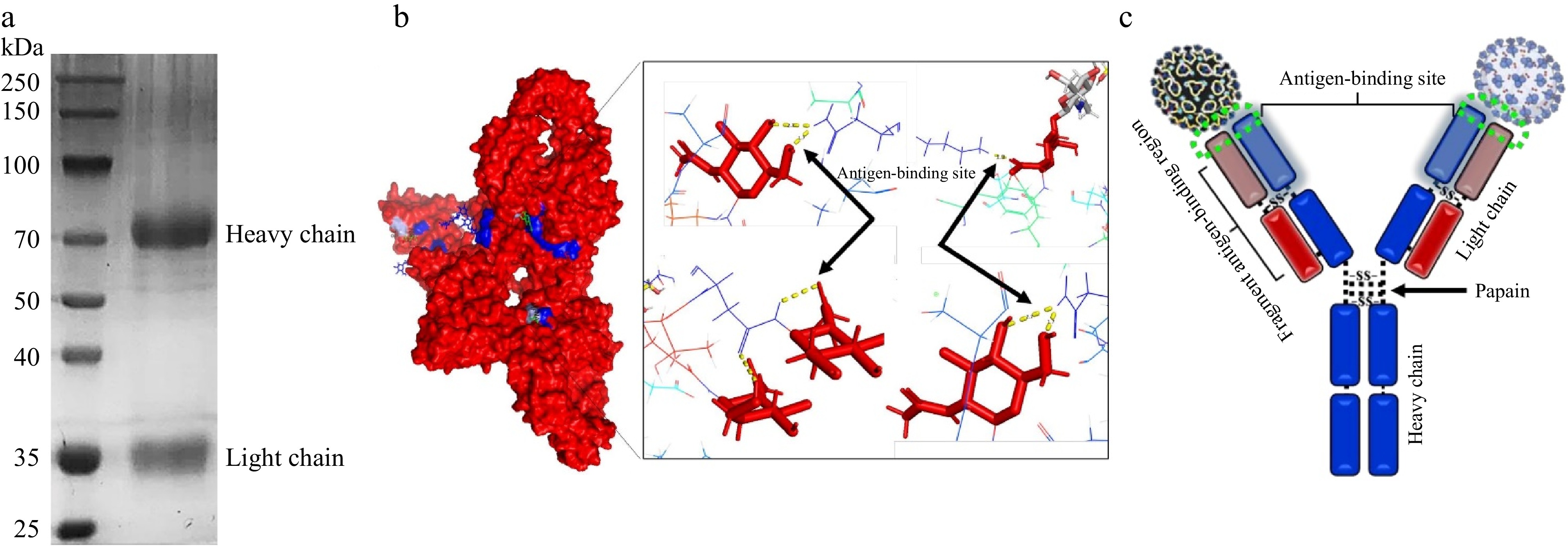
Figure 3.
(a) SDS-PAGE of IgG standard; (b) IgG antibody sites; (c) schematic representation of the basic structure of immunoglobulin.
Lactoferrin
-
A type of glycoprotein that is a member of the transferrin family, lactoferrin has an exceptionally high affinity for iron, around 260 times more than serum transferrin. Mammals' milk and colostrum, along with several other body secretions, contain it in large quantities. Its antibacterial, antifungal, antiviral, anticancer, anti-inflammatory, and antioxidant qualities allow it to perform a variety of roles in improving health[21]. These processes are essential for binding available iron and preventing microbial development. Lactoferrin, which is frequently referred to as the 'red protein' due to its strong health-promoting qualities, is present in mature milk at quantities of 0.02 to 0.75 mg/ml and in BC at 1.5 to 5 mg/ml. It also binds to iron produced during the disintegration of red blood cells thanks to its cationic character. In response to pathogen invasion, lactoferrin is also released by neutrophils, exocrine glands, and inflammatory tissues, underscoring its many vital roles in human and animal health[22]. It fights a variety of microorganisms, such as bacteria, viruses, yeasts, and protozoa, and it supports intestinal health by preventing pathogens from adhering to epithelial cells[3].
According to Csapó et al.[23], the types of lactoferrin that are present in human colostrum and BC are the same. According to several studies, lactoferrin made from BC can encourage the release of growth factors from osteoblasts and other bone-forming cells while also stimulating their proliferation[24]. Lactoferrin is also known to trigger immunological responses and phagocyte activation, as well as to aid in the intestinal absorption of iron. Monocytes, macrophages, neutrophils, lymphocytes, platelets, intestinal tissue, and some bacteria all express lactoferrin receptors[25]. Lactoferrin serves as a link between innate and adaptive immunity. Its primary job is to increase tissue oxygen levels by releasing iron into red blood cells. Apoptosis induction, antioxidant activity, microbial adhesion and proliferation, immunological mediators, cytokine production, infant formulas, intestinal inflammation, arthritis, allergic inflammation, and neurodegenerative diseases are all positively impacted by lactoferrin. Inhibits skin inflammation and activation mediated by lipopolysaccharides[1,25−27]. Considering glycosylation sites aid in defending the organism against invasive infections, it has antiviral (herpes, human immunodeficiency virus, and human cytomegalovirus), antibacterial, and antifungal properties[1]. Known for its cancer-fighting, tissue-regenerating, immune-modulating, and inflammatory cytokine-inhibiting capabilities, it can also induce apoptosis in cancer cells, increase caspase-1 and IL-18 levels to decrease metastatic foci, activate cytotoxic T- and natural killer cells, inhibit the hepatic CYP1A2 enzyme, potentially act as a carrier for chemotherapeutic agents, and improve the efficacy of chemotherapy and radiation therapy while lowering the side effects that come with them[25]. Supplementing with bovine lactoferrin is believed to boost immunity and affect immune cell activity due to its antiviral, antibacterial, and antioxidant qualities.
Growth factors
-
To support growth and development in newborn calves, BC contains a variety of growth factors, such as insulin-like growth factors (IGF-I and IGF-II), platelet-derived growth factors (PDGF), transforming growth factors (TGF-β1 and TGF-β2), fibroblast growth factors (FGF1 and FGF2), epidermal growth factor (EGF), and betacellulin (BTC)[2,28]. These are the comparatively adaptable polypeptides that cause cell surface receptors to either differentiate or proliferate cells[26]. In BC, the proportion of these growth hormones is higher in the early stages and begins to decrease as the amount of time after calving grows. The concentration of IGF-I in BC is higher than that of other growth factors. Figure 4 shows the concentrations of these growth agents. IGF-I and IGF-II concentrations in BC are substantially greater than those in mature milk, which are normally less than 10 μg/L. They vary from 50 to 2,000 μg/L, and 200 to 600 μg/L, respectively. While IGF-II shares structural similarities with pro-insulin and plays a role in fetal development, wound curative, cell propagation, and disparity, IGF-I is recognized for its varied functions in controlling cell growth, muscle development, bone healing, nerve regeneration, glucose utilization, and risk reduction for diseases such as type 2 diabetes[5,29]. While these growth factors are well-documented, it remains possible that other, less well-known growth factors may exist in BC that have yet to be identified. Further research could help elucidate any additional growth-promoting compounds in colostrum.
To sustain the steadiness among cell propagation and disparity, TGF-α and TGF-β are essential. TGF-α promotes mucosal development and repair in the gastrointestinal tract and impedes acid secretion, while TGF-β has immunomodulatory qualities that support cell proliferation in connective tissue, gastrointestinal tract integrity, and repair while also aiding in the growth of cartilage and bone. The 53 amino acid protein known as EGF aids in wound healing, the treatment of inflammatory diseases, the restoration of damaged gastrointestinal tissues, and the growth and differentiation of epidermal cells. FGF supports wound and ulcer healing, preserves bone health, and helps repair fractures; PDGF, which is released by macrophages and is made up of two polypeptide chains connected by disulfide bonds, contributes. Colostrum is known to include a variety of hormones that are essential for metabolic processes. Total and free cortisol hormone concentrations in BC were determined to be 4.4 and 1.8 ng/ml, respectively, while those in mature milk were 0.35 and 0.3 ng/ml[30]. These hormones, which are regulated by the hypophyseal, thyroid, sexual, and other bodily systems, have beneficial effects on the development of organs, celiac disease, and several physiological diseases.[31].
Enzyme
-
Renowned for its diverse composition, BC contains a wide range of enzymes essential for many physiological functions, such as lactoperoxidase, proteinases, lysozyme, ribonucleases, cysteine-protease, alkaline phosphatase, and lipase, all of which are vital for digestion, immunity, and general health. These enzymes, which are released from a variety of sources, including blood plasma, somatic cells, fat globule membranes, and cell cytoplasm, enable a wide range of biochemical processes that are essential for tissue repair, microbial defense, and nutrient absorption[3].
Lactoperoxidase is a basic glycoprotein consisting of a heme group. They catalyze the oxidation of thiocyanate, are antibacterial, inhibit the action of bacterial metabolism, and show a positive effect against HIV-137 and poliovirus due to the availability of hydrogen peroxide[3,32]. According to McGrath et al.[5], the concentrations of lactoperoxidase in BC (range 13–30 mg/L) and mature milk (range 11–45 mg/L) are almost equal; on the other hand, the concentration of plasmin is about 10-fold greater in BC compared to mature milk. The trypsin inhibitor concentration in BC was 100 times higher than that of mature milk[3]. Lactoperoxidase and other enzymes in colostrum play a vital role in various physiological functions, such as antimicrobial defense and immune system support. While these enzymes are essential for health, their absorption after ingestion by animals or humans is more complex. Research suggests that some enzymes, including lactoperoxidase, may not be fully absorbed intact in the digestive tract due to the degradation caused by stomach acids and digestive enzymes. However, small amounts of these enzymes may pass through the gut lining, where they could exert local regulatory effects. For example, lactoperoxidase can contribute to the regulation of gut microbiota and support immune responses in the gastrointestinal tract. Additionally, some peptides and fragments of these enzymes might be absorbed, influencing immune modulation and other biological pathways in the body. Further studies are needed to clarify the extent of absorption and the exact mechanisms by which these enzymes exert their effects after ingestion.
In the meantime, proteinases facilitate the breakdown of proteins during digestion, guaranteeing the effective absorption of vital nutrients and helping to regulate several physiological functions[25,33]. Digestion facilitates the movement of micro and macromolecules through the gut lining, digestion of food by chemical reactions permits the lucrative components of components to various body organs without any significant degradation[3]. Phosphatase enzymes in colostrum exist either in acid or alkaline form. The concentration of alkaline phosphatase is found to be high in colostrum, where the acid is present in a low concentration initially[3].
Lysozyme, another critical enzyme present in BC, acts as a potent antibacterial agent by catalyzing the cleavage of the glycosidic bond between N-acetylglucosamine and muramic acid in bacterial peptidoglycans, enhancing immune function[34,35]. Similarly, ribonucleases, particularly type II-1 found abundantly in colostrum, play crucial roles in RNA cleavage, facilitating various cellular processes essential for growth and development[3,36]. Additionally, cysteine-protease enzymes, integral components of kininogen, not only help in preventing bone resorption but also participate in inhibiting microbial development, further emphasizing the multifaceted role of BC in maintaining overall health and well-being[37].
Lipase enzymes, linked to casein micelles, hydrolyze triglycerides, thereby contributing to lipid digestion and absorption, while also potentially influencing conditions such as atherosclerosis and Alzheimer's disease[38]. Moreover, the concentrations of these enzymes exhibit dynamic patterns, with higher levels observed during the initial phase after calving, gradually declining as lactation progresses[39]. The significance of colostrum as a source of bioactive substances essential for the early development and well-being of neonates is highlighted by this temporal variance. BC also contains enzyme inhibitors, such as trypsin inhibitors, which control enzymatic activity, preventing the breakdown of vital growth and immunological components and guaranteeing their maximum bioavailability. Colostrum from cows is a rich source of enzymes that are important for digestion, immunity, and general health. Their varied functions highlight the colostrum's extraordinary biological relevance and complexity in supporting and nourishing life, making it a priceless resource with enormous promise for therapeutic uses in a range of medical disorders.
Interleukins and cytokines
-
Interleukins and cytokines are crucial for initiating and regulating immune responses. They act as signaling molecules that communicate between cells to trigger the body's defense mechanisms against infections. Beyond defense, they are involved in maintaining homeostasis within the body[19,40]. For instance, they help regulate cell growth, repair tissues, and control the mechanisms of inflammation. Given that a significant part of the immune system is associated with the gut, cytokines influence gut health by managing the balance of inflammatory and anti-inflammatory responses, which can affect overall wellness and digestion[3,41]. Cytokines and interleukins enhance the body's resistance to diseases by mobilizing immune cells like macrophages, T cells, and B cells to sites of infection, optimizing the clearance of pathogens. They play a dual role in managing inflammation, which is critical in disease conditions. While some cytokines promote inflammation necessary to fight infections, others help resolve inflammation to prevent excessive tissue damage[19]. Some interleukins are particularly important in shaping adaptive immunity, ensuring that the body can not only respond to infections more efficiently but also remember pathogens for faster response in future encounters[26]. Chronic low-grade inflammation is a significant contributor to aging and associated sicknesses, like arthritis, diabetes, and heart disease. Cytokines are deeply involved in this process, known as 'inflammaging'.
Cytokines like IL-6 and TNF-α have been linked to the promotion of cellular senescence, a state where cells no longer divide and begin to secrete inflammatory cytokines that lead to tissue dysfunction[3,42]. On the positive side, certain cytokines are involved in promoting tissue regeneration and repair, which are crucial for maintaining tissue function and longevity. Integrating the roles of cytokines and interleukins into a holistic approach involves recognizing their influence across multiple systems and stages of life[19,25]. A balanced cytokine response is crucial for optimal health, effective disease resistance, and a healthier aging process[1]. Modulating cytokine levels through lifestyle, diet, and potentially therapeutic interventions could enhance immune function, reduce the impact of chronic diseases, and improve quality of life as individuals age[25].
Amino acids
-
Amino acids, the organic molecules that serve as the foundational components of proteins, primarily consist of carbon, hydrogen, and nitrogen atoms[42]. These vital nutrients are grouped into three categories: essential, which must be obtained through diet; semi-essential, which is necessary under specific physiological conditions; and non-essential, which can be synthesized by the body[43]. Observational data show that amino acid concentrations are initially elevated immediately after calving but gradually decrease over time[19].
Casein, the predominant protein created from milk and colostrum, is produced within the mammary gland. It plays a critical role in transporting amino acids from the mother to the newborn, facilitating early nutritional support[2]. The role of amino acids extends beyond basic nutrition; they are pivotal in promoting the growth and development of individuals across different life stages. Additionally, they enhance enzymatic reactions, contribute to cellular metabolism, support mental health, and are involved in the secretion of anabolic hormones[19]. These diverse functions of amino acids are crucial for maintaining overall physiological health and are further elaborated in Table 2, as discussed by Mehra et al.[3].
Table 2. BC contains amino acids with health benefits.
Amino acid The benefits to health Essentials Threonine Skin's creation of collagen as well as elastin, the generation of antibodies, and a decrease in stress and anxiety. Valine Energy metabolism and muscle development as well as repair. Methionine Prevents harm to the liver, functions as an antioxidant, and lowers artery-stored fat, digestion, and production of collagen (nails and hair). Isoleucine Production of hemoglobin, control of energy and blood sugar levels, muscle growth, and post-exercise recovery. Leucine Control blood sugar levels, muscular growth and development, growth hormone synthesis, and energy balance. Phenylalanine Neurotransmitters and depression. Lysine Fatty acid conversion to energy, cholesterol reduction, calcium conservation, collagen creation (bones, cartilage, and connective tissues), and carnitine synthesis. Histidine The body's immune system secretes this precursor of histamine during allergic reactions, tissue growth and repair, RBC and WBC synthesis, heavy metal removal, and gastric juice production. Semi-essential Cysteine Uphold protein structure, communicate amongst cells of the immune system, and transform cysteine into glucose for energy. It is a part of the antioxidant glutathione. Tyrosine Control emotions and stress, decrease hunger and body fat, and enhance thyroid function. Non-essential Aspartic acid Address the production and release of hormones, the citric acid cycle, depression, and exhaustion. Typical nervous system operation. Serine Developed immune system, muscle growth, and fatty acid metabolism. Glutamic acid By far the biggest source of intestinal energy is cellular metabolism. Proline Collagen synthesis, tissue damage repair, anti-aging action (lessens wrinkles and drooping), and preservation of healthy skin and connective tissues. Glycine Serve as nerve impulse transmitters in certain spinal cord and ocular regions. Alanine Glucose metabolism protects muscles from the accumulation of poisonous and dangerous chemicals. Arginine Increases immunological response, muscle growth, wound healing, and growth hormone stimulation. Source: [5,44,45]. -
BC, containing varying concentrations of fat-soluble vitamins (vitamins A, D, and E), and water-soluble vitamins (vitamins B and C) influenced by factors like lactation stage and maternal diet, is essential for human health due to its rich content of these vital nutrients[46]. In the complex matrix of BC, which is highly valued for its diverse nutritional profile, several vital vitamins, most notably vitamin A, are found in various metabolites such as retinal, retinoic acid, retinol, retinyl ester, and beta-carotene. Each of these metabolites is essential for bolstering immune responses, inhibiting inflammatory cascades, and maintaining optimal ocular health, highlighting its critical role in fostering neonatal vitality and robustness during the critical early years of life[1,2].
Ascorbic acid, also known as vitamin C, is another essential component of BC. It plays a crucial role in promoting the production of collagen, accelerating the healing of wounds, strengthening antioxidant defenses, and protecting against debilitating diseases like scurvy. However, it is only produced in small amounts in the liver of cows, which highlights the priceless nutritional wealth contained in this liquid gold of early lactation[19,26]. As compared to mature milk, the colostrum's noticeable abundance of water-soluble vitamins provides a veritable trove of vital B vitamins, such as riboflavin (B2), niacin (B3), pyridoxal (B6), cobalamin (B12), and biotin (B7), whose necessity extends across numerous metabolic pathways, neurological processes, and cellular fortifications, giving colostrum the nutritional superiority it needs to support healthy neonatal growth, development, and vitality[42]. It is noteworthy that the vitamin content of the first milking of colostrum differs significantly from that of its more mature counterpart in that the first milking contains significantly higher levels of certain vitamins, including carotene, vitamin A, and riboflavin, demonstrating its fundamental function as nature's storehouse of essential nutrients in the early stages of neonatal life, which is essential for bolstering the developing immune system and guaranteeing that developmental milestones are met with resilience and vigor[25]. Additionally, colostrum's higher than mature milk's vitamin D content plays a critical role in immune homeostasis, calcium absorption, and skeletal integrity. Its slow decline after delivery provides valuable information about how it plays a crucial role in coordinating the immune and skeletal development of newborns, highlighting colostrum's essential role as nature's elixir that bestows health and vitality upon the young offspring of the bovine kingdom[19]. The rich tapestry of essential vitamins found within BC underscores its unparalleled nutritional value and critical role in supporting neonatal health and vitality. From fortifying immune defenses to promoting optimal growth and development, colostrum stands as nature's irreplaceable elixir, nurturing the foundation of life with its bounty of vital nutrients[25].
Minerals
-
Recent studies have unveiled that the mean concentrations of numerous essential minerals in colostrum markedly surpass those found in mature bovine milk, highlighting its unparalleled richness in trace and major minerals, predominantly present as ions or colloidal species intricately complexed with the casein protein[26]. Illustratively, the mean concentration profiles of crucial components such as chlorides, citrates, and phosphates in BC, depicted in Fig. 5, mirror similar trends observed for other bioactive compounds, with mineral concentration profoundly influenced by a myriad of internal and external factors including heat stress, environmental conditions, and dietary constituents[42].
In particular, BC and mature milk emerge as formidable sources of various minerals, notably calcium, and phosphorus, with the former exhibiting concentrations four to five times higher than its mature counterpart, existing in a dynamic equilibrium between colloidal and serum states[2]. Notably, colostrum from multiparous cows contains higher calcium levels than that from primiparous cows, emphasizing calcium's crucial role in promoting calf development and ensuring strong skeletal structures and dental health[47]. Similarly, phosphorus plays a key role in regulating metabolic processes, supporting skeletal tissue development, optimizing energy utilization, and protein synthesis, and facilitating fatty acid transport, highlighting its essential function in maintaining physiological homeostasis[42]. Furthermore, several studies have reported elevated levels of sodium, potassium, and magnesium in BC, which are critical for maintaining osmotic balance, acid-base regulation, and various metabolic processes. Magnesium, zinc, and selenium are also abundant, with magnesium playing a significant role in promoting intestinal peristalsis and aiding in the expulsion of meconium during neonatal development[25].
Both milk and colostrum include trace levels of about 20 macro elements, such as manganese, iron, and zinc. Notably, colostrum contains zinc and copper, which are vital antioxidants, along with iron levels that are remarkably 10- to 17-fold higher than those of mature milk. These components are essential for maintaining physiological homeostasis and general vitality because they counteract free radicals, promote cellular growth, and improve regeneration processes[1,3]. Furthermore, iron and sulfur are vital for blood formation, immune modulation, temperature regulation, and antibacterial defenses, emphasizing the comprehensive nutritional value of BC in promoting health and development[42].
Fatty acids
-
Fatty acids (FAs) in milk fat are critical components of the human diet, providing a range of health benefits[8]. Although colostrum is often overlooked for its fat content, it plays a vital role in nutrition and thermogenesis, helping to regulate body temperature[2]. However, concerns have been raised regarding colostrum fat due to its higher levels of saturated FAs, which have been linked to health issues such as obesity, weight gain, and cardiovascular diseases[19]. Consequently, maintaining a balanced intake of fats is essential for optimal health, emphasizing the importance of understanding these potential effects[3]. Branched-chain saturated fatty acids (BCSFA), odd-chain saturated fatty acids (OCSFA), long-chain saturated fatty acids (LCSFA), polyunsaturated fatty acids (PUFA), monounsaturated fatty acids (MUFA), trans fatty acids (TFA), short-chain saturated fatty acids (SCSFA), and conjugated linoleic acid (CLA) are among the fatty acids that are classified according to their structural configurations (Fig. 6). Compared to mature milk, colostrum has a larger lipid content and higher concentrations of myristic, palmitic, and palmitoleic acids. Notably, oleic acid, a crucial fatty acid, has anti-atherogenic properties that improve HDL's antioxidative qualities and prevent LDL particles from oxidizing, thus improving general health[42].
The diverse fatty acid composition of milk, including stable oleic acid and biologically active polyunsaturated fatty acids (PUFAs), highlights their importance in human nutrition[8]. While the concentrations of certain fatty acids diminish over time, others remain abundant, supporting various physiological functions[25,48]. The presence of beneficial compounds such as butyric acid and conjugated linoleic acid in dairy products further enhances their nutritional value. Specific saturated fatty acids, such as branched-chain (BCSFA) and odd-chain saturated fatty acids (OCSFA), have been linked to reduced breast cancer risk and improved gut health. Additionally, short- and medium-chain saturated fatty acids play crucial roles in cellular metabolism and antimicrobial defense, underscoring the wide-ranging health benefits of these compounds[2].
Conjugated linoleic acid (CLA), a key component of dairy fat, offers significant health benefits, including anti-carcinogenic, and anti-obesity properties[25]. Although trans fatty acids are present in small amounts in milk fat, their influence on cholesterol levels highlights the importance of consuming them in moderation[42]. Examining the fatty acid composition of colostrum from multiparous cows provides valuable insights into its nutritional profile[3,49]. The combined contributions of branched-chain saturated fatty acids (BCSFA) and odd-chain saturated fatty acids (OCSFA) emphasize the need for a balanced intake of fats to maintain overall health.
Carbohydrates
-
Carbohydrates exist as complex compounds either in conjunction with lipids and proteins or as standalone entities in BC. This includes a variety of complex carbohydrates such as oligosaccharides, glycoproteins, nucleotide sugars, and mucins[2]. Among these, lactose emerges as the primary saccharide, comprising approximately 17% of BC (based on proteins, fats, vitamins, and minerals), as shown in Fig. 1. Initially, lactose concentration in BC is relatively low but increases progressively after calving. BC is also a rich source of complex oligosaccharides and glycans, exhibiting a high degree of selectivity[26,50]. The concentration of oligosaccharides in colostrum typically ranges from 0.7 to 1.2 mg/mL, as illustrated in Fig. 7. Notably, a significant portion of these oligosaccharides is acidic and more abundant in colostrum than in mature bovine milk[51].
Lactose, a critical energy source in BC, is composed of glucose and galactose and plays an essential role in supporting vital functions in organs such as the heart, brain, and spinal cord[52]. Oligosaccharides in colostrum are categorized into neutral and acidic types, with neutral galacto-oligosaccharides lacking charged residues and acidic oligosaccharides containing N-acetylneuraminic acid residues[53]. Their concentration, typically ranging from 0.7 to 1.2 g/mL, is primarily acidic and can vary based on several influencing factors. Approximately 40 oligosaccharides have been identified in colostrum, with 3-sialyl-lactose and sialyl-lactosamine being prominent acidic forms. The major oligosaccharides present in milk and colostrum, such as lactose, 6-Sialyl-lactose, 3-Sialyl-lactose, Sialyl-lactosamine, Sialylgalactosyl-lactose, Disialyl-lactose, and Sialyl-lactose-1-phosphate, exhibit bioactive properties as dietary oligosaccharides[51]. They act as prebiotics, providing a low osmolar energy source and serving as soluble receptors for pathogenic bacteria and viruses. These compounds mimic epithelial cell-surface carbohydrates, competing with virulent bacteria and viruses for attachment sites, potentially reducing infection rates. Sialylated oligosaccharides have been shown to prevent the binding of pathogenic strains of Escherichia coli in neonates, as well as other pathogens[53].
In contrast to human milk oligosaccharides, which are primarily sialylated and less fucosylated, bovine milk oligosaccharides have garnered a lot of interest due to their potential to improve human nutrition and health via regulating the gut flora[52]. Recent developments in enzymatic glycosylation have provided chances to improve the structure of bovine milk oligosaccharides to more nearly match human milk oligosaccharides, notwithstanding structural discrepancies[2]. Their extensive usage has been restricted by difficulties in milk processing, specifically the separation of oligosaccharides from high lactose concentrations. Ongoing research, however, attempts to get around these challenges and capitalize on their possible health advantages. Promising in vitro trials, particularly in babies, indicate that these oligosaccharides may have a substantial role in modifying gut microbial populations and enhancing health outcomes, warranting additional exploration, despite the mixed results of adult pilot studies[8,26,50].
-
BC is recognized for its high immunoglobulin content, particularly IgG, which plays a crucial role in strengthening the immune system[2]. This immune-boosting property is especially effective in reducing susceptibility to various infections, including those affecting the gastrointestinal and respiratory systems[19,42]. Studies suggest that BC supplementation can lead to a reduction in the frequency of illness in populations susceptible to upper respiratory tract infections. BC holds robust antimicrobial activity against both Gram-positive and Gram-negative strains[8]. Colostrum was discovered to have a minimum inhibitory concentration (MIC) against S. aureus, P. vulgaris, E. aerogenes, S. typhi, and E. coli. Colostrum from cows may be viricidal to the COVID-19 virus[42]. Especially immunoglobulins and lactoferrin are well-identified for their anti-bacterial and anti-inflammation features[1,25].
Gastrointestinal health promotion
-
The gastrointestinal tract significantly benefits from the growth factors in BC, such as IGF and TGF-β, which aid in the repair and regeneration of the intestinal lining[8,19]. These properties are particularly valuable in managing and potentially treating conditions like leaky gut syndrome, where the intestinal barrier's integrity is compromised, as well as in inflammatory bowel diseases (IBD) such as Crohn's disease and ulcerative colitis, by promoting mucosal healing[26,42]. Immunity is closely related to physical health, and this study emphasizes the significant benefits of BC supplementation across various life stages. BC's bioactive components, such as immunoglobulins, growth factors, and cytokines, are pivotal in enhancing the immune system. In infancy, BC supplementation compensates for immunodeficiency in preterm infants by promoting the development of a robust immune barrier in the gut. This barrier, primarily composed of specific immune cells and proteins, reduces the incidence of feeding intolerance, necrotizing enterocolitis, and late-onset sepsis[14]. These effects are largely attributed to the immunoglobulins and cytokines in BC, which help establish and regulate immune function.
During adolescence, BC plays a crucial role in reducing the frequency of gastrointestinal and upper respiratory infections. This is largely due to its ability to modulate the gut microbiota and enhance systemic immunity. The immunoglobulins in BC effectively neutralize pathogens, while growth factors like IGF-1 facilitate tissue repair and regeneration. This reassures us of the significant benefits of BC supplementation during this crucial life stage[13−16].
For older people, BC supplementation offers a beacon of hope in alleviating the decline in immune function associated with aging. The growth factors in BC, such as IGF-1 and TGF-β, promote tissue repair and reduce oxidative stress, which is linked to aging[29]. Furthermore, BC has been shown to modulate inflammatory pathways, helping to reduce the release of pro-inflammatory cytokines that contribute to chronic diseases in older adults. This potential of BC supplementation is a reason for optimism in the face of aging.
-
This systematic review, encompassing 187 published sources, examines the composition of BC, the factors affecting it, its function as a dietary supplement (commercial and traditional), the outcomes of clinical studies, and the health benefits of each component. This comprehensive overview guarantees that we are adequately informed. Given the varied research evidence, we can assert that BC is the 'single most important food in the world. As a result of its many potential health benefits, BC has grown in popularity in the pharmaceutical and nutraceutical businesses as public interest in natural health solutions increases. Well-known for its abundance of immunoglobulins, growth factors, and bioactive chemicals, it promotes gut health, immunological function, and the management of disorders like cancer and autoimmune diseases. Despite being generally safe, its usage should be cautious because it can trigger allergic responses in people who are sensitive to dairy. Further research is required to better understand its interactions with medications, especially in patients with chronic conditions. Its capacity to affect drug absorption and other physiological reactions emphasizes how crucial it is to take possible interactions into account in clinical settings. Furthermore, there is promise in using BC in customized formulations for kids, the elderly, and those with long-term illnesses, particularly in environments with low resources where cost-effective substitutes for synthetic medications are required. Further expanding its potential medicinal uses, recent research also indicates that BC may help fight viral infections like COVID-19. BC appears to have a bright future in both illness prevention and therapy, making it a useful supplement to natural medicines as research advances.
-
Not applicable.
Jiangsu Tianmeijian Nature Bioengineering Co., Ltd., Nanjing, China, provided support for the study. The authors thank Chen Qing and Anping Rao for their guidance and financial support. We also extend our gratitude to Tianmeijian for providing all the figures in this article.
-
The authors confirm contribution to the paper as follows: conceptualization: Alnadari F, Ibeogu IH, Shoura HE, Wang R, Yar MS, Chen C, Nasiru MM; literature review: Alnadari F, Ibeogu IH, Yar MS; original draft writing: Alnadari F, Ibeogu IH; data extraction and table preparation: Shoura HE, Wang R; revision, editing, and supervision: Alnadari F, Chen C, Nasiru MM; funding acquisition: Chen C, Nasiru MM. All authors reviewed the results and approved the final version of the manuscript.
-
The datasets generated during and/or analyzed during the current study are available from the corresponding author on reasonable request.
-
Authors Fawze Alnadari and Rongchang Wang are employed by the Research and Development Center of Jiangsu Tianmeijian Nature Bioengineering Co., Ltd., Nanjing, China. Author Chao Chen is employed by the Research and Development Center of Tianmeijian Biotechnology (Beijing) Co., Ltd., China. The companies had no role in the study design, data collection, analysis, or manuscript preparation. The remaining authors declare that the research was conducted in the absence of any commercial or financial relationships that could be construed as a potential conflict of interest.
- Copyright: © 2025 by the author(s). Published by Maximum Academic Press on behalf of Nanjing Agricultural University. This article is an open access article distributed under Creative Commons Attribution License (CC BY 4.0), visit https://creativecommons.org/licenses/by/4.0/.
-
About this article
Cite this article
Alnadari F, Ibeogu IH, Shoura HE, Wang R, Yar MS, et al. 2025. Immunomodulatory potential of bovine colostrum: a holistic perspective on health, disease resistance, and aging. Animal Advances 2: e003 doi: 10.48130/animadv-0025-0001
Immunomodulatory potential of bovine colostrum: a holistic perspective on health, disease resistance, and aging
- Received: 01 November 2024
- Revised: 18 December 2024
- Accepted: 08 January 2025
- Published online: 24 January 2025
Abstract: Bovine colostrum (BC), rich in nutrients and bioactive components, is utilized in supplements that target a variety of health issues. These include diabetes, inflammatory bowel disease, various skin illnesses, immunological and allergy problems, cardiovascular diseases, and neurological disorders like aging, dementia, and Alzheimer's. BC is also known to improve sports performance. BC's promise in non-pharmaceuticals and nutraceuticals is supported by the current chapter's preclinical and clinical findings. Growth factors, oligosaccharides, B-type vitamins, and immunoglobulins (IgG, SIgA, IgM, IgA, IgD, and IgE) are all present. Because of its anti-inflammatory and antioxidant qualities, lactoferrin, and lactalbumin in BC are very crucial in cancer treatment. In addition to lowering body fat, BC promotes the growth of the gastrointestinal tract, the immunological system, and muscle mass. Additionally, colostrum-based goods are readily accessible in global marketplaces and include powder, pills, and traditional food items. Given the exorbitant prices of synthetic medications, especially in areas with limited resources, BC offers a practical and reasonably priced substitute. Further investigation into the effectiveness of BC in treating viral infections, such as COVID-19, may shed more light on its possible medical uses.
-
Key words:
- Bovine colostrum /
- Bioactive components /
- Disease Resistance /
- Gut health /
- Aging


